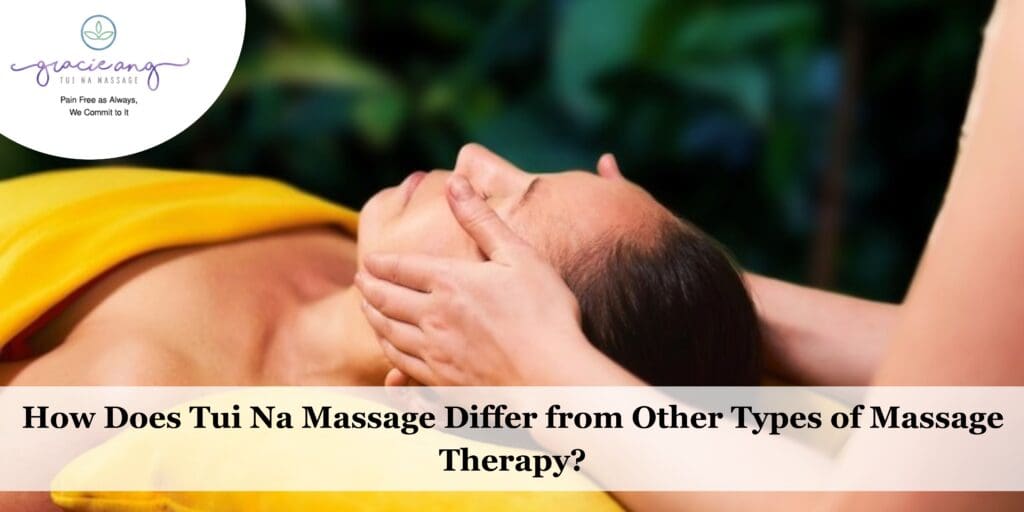How Does Tui Na Massage Differ from Other Types of Massage Therapy?

Tui Na massage, a traditional Chinese therapeutic practice, has been utilized for over 2,000 years to treat various health conditions. Unlike Western massage techniques, Tui Na focuses on balancing the body’s energy, or “qi,” and addressing both physical and emotional issues.
This holistic approach sets it apart, making it a unique and effective option for many individuals. Studies have shown that Tui Na can significantly improve pain, mobility, and overall well-being, highlighting its potential benefits.
In this blog, we will explore how Tui Na massage differs from other types of massage therapy. We will cover ten key aspects of Tui Na, including its techniques, benefits, and applications. By the end, you will understand why this is distinct and how it can be an effective therapy for various health issues.
Things That Make Tui Na Massage Unique From Others
- Holistic Approach
Tui Na massage is rooted in Traditional Chinese Medicine (TCM) and focuses on the body’s overall balance. Unlike Western massages, which often target specific muscle groups for relaxation, Tui Na addresses the flow of energy (qi) throughout the body.
This approach aims to harmonize the mind and body, providing comprehensive health benefits.
- Techniques Used
Tui Na employs a variety of techniques, such as pushing (Tui), grasping (Na), pressing, kneading, and rolling. Each technique targets specific acupressure points and meridians to stimulate energy flow and alleviate blockages.
This diverse range of methods distinguishes it from other massage therapies that typically use more uniform strokes.
- Therapeutic Goals
While Western massages like Swedish or deep tissue focus primarily on muscle relaxation and tension relief, this aims to treat specific health conditions. It is often used to address chronic pain, musculoskeletal issues, and even internal disorders by restoring the body’s natural balance.
- Integration with Other Therapies
Tui Na is often combined with other TCM practices, such as acupuncture, moxibustion, and herbal medicine. This integration enhances its effectiveness and provides a more comprehensive treatment plan. Western massages generally do not incorporate such a wide array of complementary therapies.
- Focus on Energy Flow
The central concept of qi in TCM differentiates Tui Na from other massage types. Practitioners focus on unblocking energy pathways to promote healing and well-being.
This energy-centric approach is unique to TCM and is not typically found in Western massage practices.
- Customization
Each Tui Na session is highly customized to the individual’s health needs. Practitioners assess the patient’s condition and tailor the techniques accordingly.
This personalized approach contrasts with the more standardized methods often used in Western massages.
- Emotional and Mental Benefits
Tui Na not only addresses physical ailments but also aims to improve emotional and mental health. By balancing the body’s energy, it can help reduce stress, anxiety, and emotional imbalances, offering a more holistic benefit compared to Western massage therapies.
- Effectiveness in Treating Chronic Conditions
Tui Na has been shown to be effective in managing chronic conditions such as arthritis, migraines, and digestive issues. Its ability to stimulate specific acupressure points makes it particularly useful for long-term health problems that require ongoing management.
- Cultural and Philosophical Roots
The philosophical foundation of Tui Na, based on TCM principles like Yin and Yang and the Five Elements, gives it a distinctive cultural background.
This philosophical depth is not typically present in Western massage practices, which focus more on physical techniques and immediate relief.
- Practitioner Training
Tui Na practitioners undergo specialized training in TCM, which includes a deep understanding of the body’s energy pathways and how to manipulate them.
This extensive training differentiates them from Western massage therapists, who may not have the same level of education in holistic health practices.
Types of Tui Na Massage
| Types | Description | Benefits |
| Rolling | Uses the back of the hand to roll over the muscles in a rhythmic motion. | It relieves muscle tension, improves circulation, and promotes relaxation. |
| One-Finger Technique | Applies pressure with a single finger to stimulate specific points on the body. | Targets specific acupressure points, reduces pain, and improves energy flow. |
| Pushing (Tui) | Utilizes the palm or fingers to apply pressure in a pushing motion along meridians. | It unblocks qi flow, relieves pain, and improves organ function. |
| Grasping (Na) | It involves grasping and lifting the muscles and skin. | Releases muscle tension, promotes relaxation, and enhances blood circulation. |
| Kneading (Rou) | Circular, kneading motions are applied to muscles and joints. | It relieves muscle stiffness, reduces pain, and improves joint mobility. |
| Pressing (An) | Uses steady pressure applied with the fingers or palms to acupressure points. | It alleviates pain, reduces stress, and promotes the flow of qi. |
| Rubbing (Mo) | Gentle, rhythmic rubbing motions across the skin. | It warms the area, increases blood flow, and relaxes muscles. |
| Vibrating (Zhen) | Rapid, oscillating movements with the hand or fingers. | It relieves muscle spasms, improves nerve function, and enhances energy flow. |
| Shaking (Yao) | Shaking or vibrating the limbs and body to loosen muscles and joints. | Improves flexibility, reduces muscle stiffness, and enhances circulation. |
| Percussion (Ji) | Rhythmic tapping or striking motions with the hands or fingers. | Stimulates muscles, increases energy, and improves blood circulation. |
| Traction (Ba Shen) | Gentle pulling and stretching of the limbs and spine. | It aligns the spine, relieves joint pain, and enhances flexibility. |
| Rotating (Gun Fa) | Circular movements are applied to joints to enhance mobility and flexibility. | Improves joint health, reduces pain, and increases range of motion. |
Conclusion
Tui Na massage offers a unique and holistic approach to health and wellness, distinct from Western massage therapies. By focusing on the body’s energy flow and integrating various techniques and complementary therapies, this provides comprehensive benefits for both physical and emotional well-being. If you’re seeking a massage that addresses deeper health issues and promotes overall balance, Tui Na may be the right choice for you.Experience the benefits of Tui Na massage at Gracie Ang. Visit their website to book an appointment and discover the healing power of this massage.
